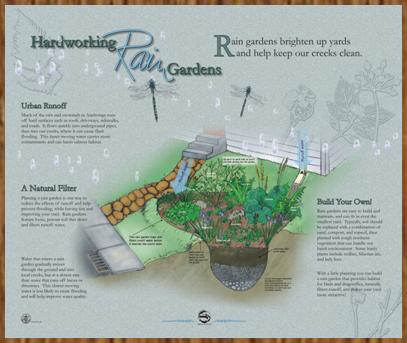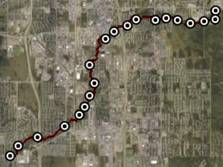Raingarden Display - 61° 9' 6" N, 149° 52' 50" W

■



|
 Visit the Trail Visit the Trail(Google Earth Required) |
 Site Navigation |
 
|
 
|
|
Raingarden Display - 61° 9' 6" N, 149° 52' 50" W |
 ■ |
|||||


|
||||||
|
|
Hardworking Rain GardensRain gardens brighten up yards and help keep our creeks clean.Urban RunoffMuch of the rain and snowmelt in Anchorage runs off hard surfaces such as roofs, driveways, sidewalks, and roads. It flows quickly into underground pipes, then into our creeks, where it can cause flash flooding. This faster moving water carries more contaminants and can harm salmon habitat. A Natural FilterPlanting a rain garden such as the one illustrated on the panel is one way to reduce the effects of runoff and help prevent flooding, while having fun and improving your yard. Rain gardens feature loose, porous soil that slows and filters runoff water. Water that enters a rain garden gradually moves through the ground and into local creeks, but at a slower rate than water that runs off lawns or driveways. This slower moving water is less likely to cause flooding and will help improve water quality. Build Your Own!Rain gardens are easy to build and maintain, and can fit in even the smallest yard. Typically, soil should be replaced with a combination of sand, compost, and topsoil, then planted with tough northern vegetation that can handle our harsh environment. Some hardy plants include trollius, Siberian iris, and lady fern. With a little planning you can build a rain garden that provides habitat for birds and dragonflies, naturally filters runoff, and makes your yard more attractive! |